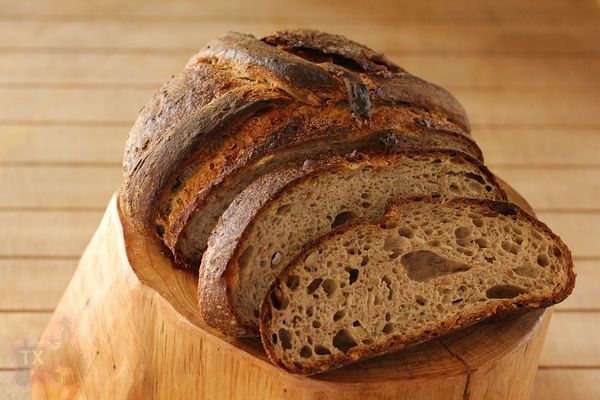
Another classic from "Bread". As always, I eliminated commercial yeast and extended rising time accordingly. So fragrant and delicious. Original recipe makes a lot of bread, which is a good thing, because they disppeared really fast. Of course I increased hydration, because my whole rye flour is very thirsty - and because I am a sucker for wet dough. My rye starter is way fast, especially in this weather, and this bread has a very high levain ratio, which means that it's a pretty fast bread to make.
Shaping method for the round loaf can be found at: http://techno.boulangerie.free.fr/09-ReussirLeCAP/03-lesFormesEnVideo/20.LeCordon.html
Five-Grain Sourdough with Rye Sourdough (adapted from "Bread")
Note: makes 3X730g loaves
- Levain
whole rye flour, 226g
water, 190g
rye starter (100%), 11g
1. mix and let rise for 12 to 16 hours.
- Soaker
flaxseeds, 82g
rolled rye, 82g
sunflower seeds, 68g
oats, 68g
salt, 20g
water, 374g
2. mix and cover, leave overnight
- Final dough
bread flour, 680g
water, 340g
honey, 14g
leavain, 417g
soaker, all
3. mix everything and autolyse for 30min.
4. knead until low-medium gluten development. rise at room temp (74F) for 2 hours, S&F @ 30 and 60min.
5. divide, preshape, let rest for 20min.
6. shape and proof for about 70min.
7. bake @450F with steam for 15 min. lower to 430F, let go of steam, keep baking for another 30 to 35min.
Wrapped up and ready to be eaten.

How can it NOT be delicious with this many seeds and grains?

Crumb is pretty open for a bread with 25% whole rye, and this much seeds.

Sending this to Yeastspotting.
- txfarmer's Blog
- Log in or register to post comments
Txfarmer,
Beautiful loaves once again! I love the shaping technique. The hands in the video make it appear to be so simple....I have trouble with thick ropes - can't imagine rolling small ones but now my curiosity has been piqued so I will have to give it try :-)
I have a question about your autolyse. My understanding is that the only ingredients that term applies to are flour and water yet in your formula all ingredients are used. Does it still have the same effect? (I have read in other threads and in books that the purpose of an autolyse being used is so that the flour absorbs more water without competition from salt or other thirsty ingredients.)
Janet
Autolyse in the strict sense is just flour and liquid, but baking is not black and white. Salt and yeast in theory would tighten the gluten and affect rising time, but in reality, you can get most of autolyse benefits even if you dump everything in together. One exception is when it's really hot and you use a lot of commercial yeast in the dough, then you will risk over-rise by adding the yeast too early. In my case, I used starter, which is much slower than commercial yeast anyway, so I felt comfortable with adding it early.
Another thing to consider is when the levain/poolish is liquid, then you need to add it early otherwise the final dough won't have enough water.
Thanks for the explanation. It helps to understand why things are being done when they are being done.
I have experimented and have run into the hard lump of dough that nothing will penetrated if not mixed together early on.....I haven't seen too much of a difference in the final outcome either but I have experienced total decomposition of some of my loaves when cinnamon has been added too early.....tricky stuff cinnamon is - especially when used with SD.....long fermenting times just don't seem to work - in fact I had to toss out a lump of dough just this morning that I had tried to retard overnight....not a pretty sight!
Again, thanks for the explanation!
Janet
David
beautiful loaves and exquisite photograpy, txfarmer! What kind of camera do you use?
Beautiful loaves... inspiring. I love seeded bread and your variation looks delicious!